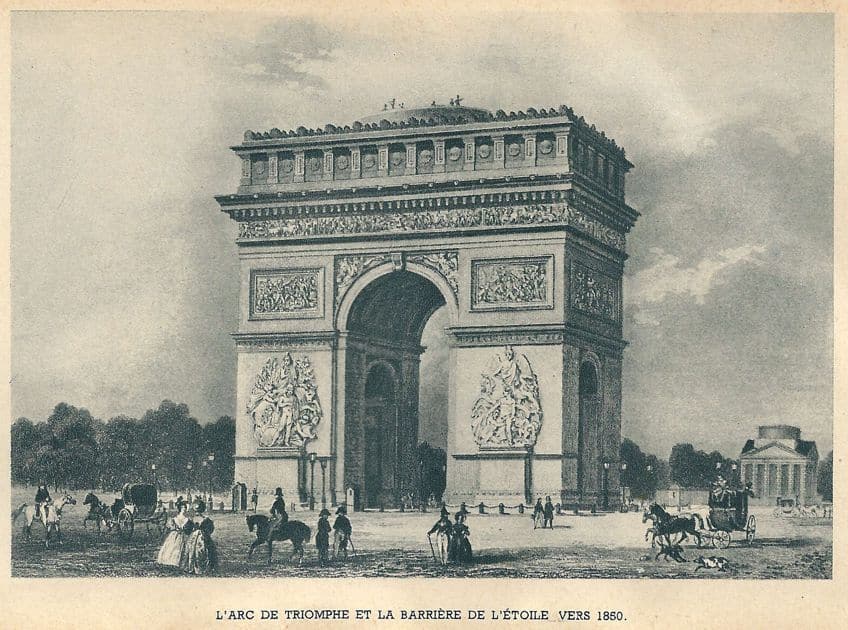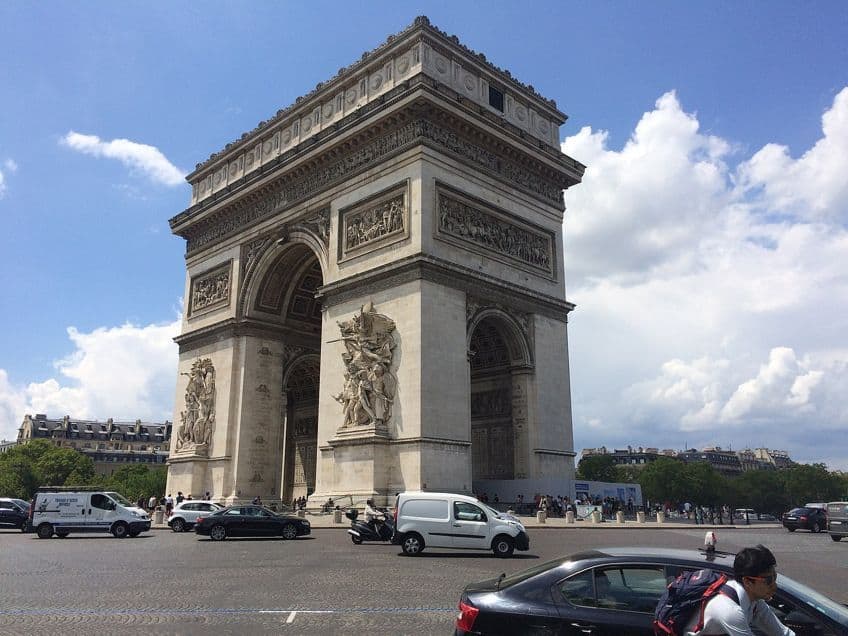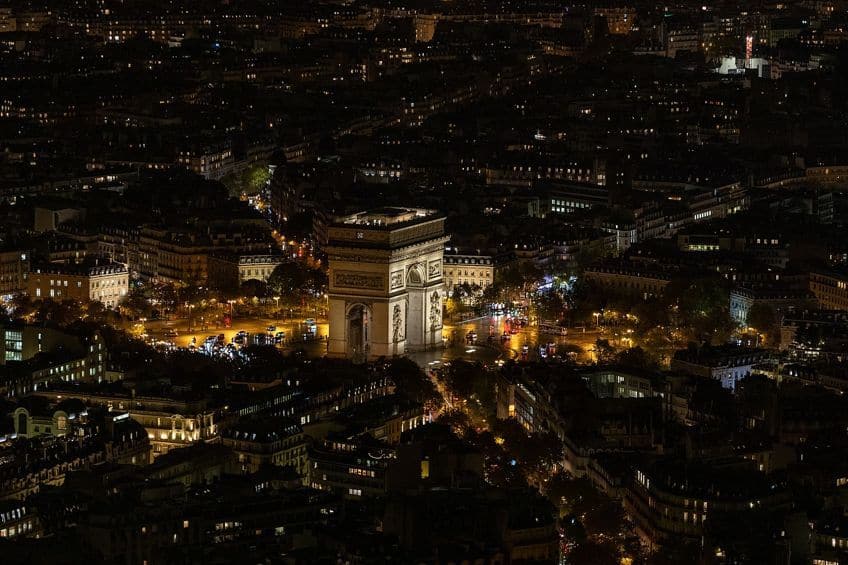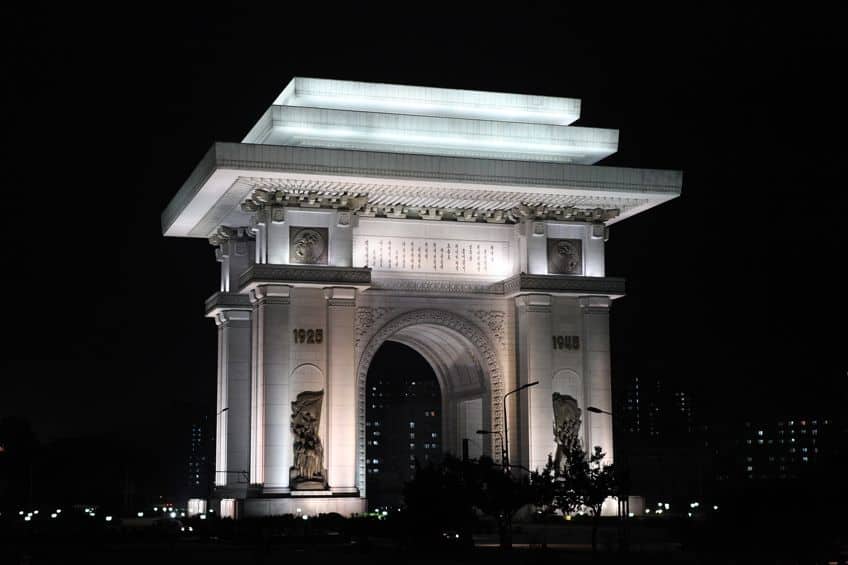Arc de Triomphe – The History of the Triumphal Arch in Paris
The Arc de Triomphe is a triumphal arch in Paris, and it is one of the most recognizable landmarks in the city. This article will look at various aspects of this arch of triumph in Paris, and answer questions such as “when was the Arc de Triomphe built?”, “why was the Arc de Triomphe built?”, “who built the Arc de Triomphe?” and, of course, “how tall is the Arc de Triomphe in the first place?”. Continue reading to find out about all of this and more!
A Look at the Arc de Triomphe
| Architect | Jean Chalgrin (1739 – 1811) |
| Date Constructed | 1806 – 1836 |
| Function | Triumphal arch |
| Location | Paris, France |
The Arc de Triomphe is an incredibly large triumphal arch in Paris, and as such, it was built to commemorate a victory. This is what arches have traditionally been built to celebrate, such as the Arch of Titus and the Arch of Constantine in Ancient Rome. In this case, this arch of triumph in Paris has a full title that is generally neglected in favor of the shorter “Arc de Triomphe” that we are all accustomed to. The full name of this arch is the “Arc de Triomphe de l’Étoile.” This translates to the “Triumphal Arch of the Star” in English and it is situated in the center of a busy intersection that makes visiting it in the modern day more of a challenge than it may have originally been. This triumphal arch in Paris is also considered to be the lynchpin of the historic axis.

The historic axis is a large collection of thoroughfares and monuments that run throughout the city of Paris. They run from the Courtyard of the Louvre all the way to the outside of the city itself, and the Arc de Triomphe is the central piece of this collection. And as a triumphal arch, it was inspired by other arches of a similar design. In fact, the previously mentioned Arch of Titus serves as a direct influence on this grand arch.
Who Built the Arc de Triomphe?
The man who decided to base this monument on the Arch of Titus was Jean Chalgrin. He was the architect placed in charge of the initial construction of this now-famous monument to French victories through the ages. He was inspired by the famous Ancient Roman arch to adopt a Neoclassical style that he brought to the Arc de Triomphe. However, Chalgrin was only the architect. Most regular architects do not have the money or power to order the construction of something like this, so who built the Arc de Triomphe then? Well, it was commissioned by Emperor Napoleon I during the height of his power and authority, but he never saw this arch of triumph in Paris in a complete state.
Instead, construction was only completed under King Louis-Philippe during his reign over the country.
By that point, there had also been changes to the overall structure, some additional sculptures supplemented the arch, and it may not have ended up the way that it was initially intended by either Napoleon, the initial commissioner, or Chalgrin, the initial architect. However, it was still ultimately built with the same purpose that it started its life. You may still wonder though: when was the Arc de Triomphe built in the first place? When was it started and when was it finished?
When Was the Arc de Triomphe Built?
The Arc de Triomphe was officially commissioned in 1806 by Emperor Napoleon I, but that does not mean that he ever saw it finished. In addition, monuments of this scale are never finished in any kind of a hurry. Napoleon fell from power for the first time as the Bourbon Restoration came into play. So, Napoleon would not remain in power to see the construction of this triumphal arch in Paris. The construction of the arch itself was in a state of limbo for some time, but when King Louis-Philippe came to power, he wanted to supplant Napoleon as a dominant political figure. Under his orders, the Arc de Triomphe continued construction between 1833 and 1836. It would finally be completed by 1836 and officially unveiled to the public.

However, as there were alterations and such to the original design over the years, the end result, which is one of the most famous triumphal arches in the world, was not necessarily what Napoleon had envisioned. Regardless of this, the overall purpose of this arch of triumph in Paris remained the same throughout its construction. So then, why was the Arc de Triomphe built in the first place then?
Why Was the Arc de Triomphe Built?
The Arc de Triomphe was built for the same reason that all triumphal arches are built: it was meant to commemorate a victory of some kind. In this particular case, the Arc de Triomphe was built to commemorate the French citizens who fought and died to ensure French victories. As this arch of triumph was commissioned by Napoleon, it should come as no surprise that this arch was specifically meant to signify the victories of the French Revolution and the Napoleonic wars.
For this reason, the Arc de Triomphe is full of sculptures by various famed sculptors, such as Jean-Pierre Cortot, James Pradier, and Philippe Joseph Henri Lemaire.
These sculptors carved celebrations of various victories into four major sculptural groups that celebrated various aspects of French history, such as a commemoration of the French First Republic and a dedication to the Treaty of Paris. Furthermore, the military monument was engraved with the names of many French generals during these two major periods of strife. The Arc de Triomphe has stood for nearly two centuries as a commemoration of the struggles faced by the French people during these influential conflicts. However, as this is a massive monument to these victories, you may wonder just how tall is the Arc de Triomphe.
How Tall Is the Arc de Triomphe?
The Arc de Triomphe rises high above everything around it and stands at a height of 50 m (or 164 ft). It also has a width of 45 m (or 148 ft) and a depth of 22 m (or 72 ft). However, that is only part of the magnificent size because the Arc de Triomphe is constructed with two major vaults. There is a central vault that goes through the center and a smaller vault that goes through the side. This means that the Arc de Triomphe has four entryways.

The central vault stands at a height of 29.9 m (or 95.8 ft) and the smaller vault on the side of the structure stands at an equally impressive, but not as impressive, 18.68 m (or 61.3 ft). For this reason, this triumphal arch was once the tallest in the world. It was eventually replaced by the Monumento a la Revolución in Mexico City in 1938. This triumphal arch stands at 67 m (or 220 ft), but the Arc de Triomphe was the tallest arch of its kind for just over a century. And that is an impressive history to possess for so long.
The Arc de Triomphe History
The Arc de Triomphe began its life in 1806 when it was commissioned by Emperor Napoleon I, but he never saw the construction of this triumphal arch completed. However, in 1810, when he married the Austrian Archduchess Marie-Louise, he did order a full-scale replica to be constructed so that all could see what the Arc de Triomphe would eventually look like. This structure was made of painted wood.
Then Napoleon was forced from power and eventually died.
He was replaced as the commissioner of the construction of this grand monument. It was instead finished under the order of King Louis-Philippe. It was ultimately completed in 1836. While Napoleon may not have completed the monument that he set out to create, his body was carried through the arch when he died. The Arc de Triomphe thereafter became an arch used for various military parades and other events, such as being used as part of the state funeral of Victor Hugo, the famed writer most known for Les Misérables and The Hunchback of Notre Dame. Other than these uses, military parades like the annual Bastille Day use this monument as part of the festivities.

However, in 1921, the Tomb of the Unknown Soldier was installed underneath the arch as a commemoration of the sacrifices that were made during the First World War. In addition, an eternal flame of remembrance, which is relit every night, was installed beside this symbolic tomb of military sacrifice. After the installation of the Tomb of the Unknown Soldier, parades no longer march through the arch itself out of a sense of respect.
In fact, this was even respected by Adolf Hitler when his forces claimed Paris during the Second World War. That tomb would serve as an eternal reminder of the sacrifices that were made in such a large conflict.
In the modern day, there’s a reduced need for overtly militaristic symbols, and so the Arc de Triomphe is now a tourist destination. There is a small, permanent museum in the arch itself, and you can ascend to the terrace if you so desire. There’s a gorgeous view of the city from up there and it is open to the public but, as is the case with many tourist destinations, there will be a monetary charge.
Some Facts About the Arc de Triomphe
- At the end of World War One, a plane flew under the arch. This stunt was performed by Charles Godefroy in a biplane, and he flew straight under the arch’s primary vault. The whole stunt was captured on film and it was done in commemoration of the end of the war.
- The Arc de Triomphe has served as an inspiration to other arches. One of the arches that it inspired is the Arch of Triumph in Pyongyang in North Korea. This arch is also slightly taller than the Arc de Triomphe as it sits at 60 m (or 197 ft).

- Every year, the Tour de France ends near the Arc de Triomphe. As it is a triumphal arch in Paris, it makes sense that a grueling sporting event like the Tour de France would end there. The arch may have been intended to celebrate military victories, but many victories worthy of celebration can occur in a country.
The Arc de Triomphe is itself a triumph. It is a massive triumphal arch that stands high above many of the buildings around it, and it serves as an eternal reminder of the hardships that were faced by the French people through some of the hardest struggles of their existence.
Frequently Asked Questions
When Was the Arc de Triomphe Built?
The Arc de Triomphe was built between 1806 and 1836. However, this was not continuous construction as there were changes to the political leadership at the time. The construction started during Napoleon’s time, but it was only finished during King Louis-Philippe’s time.
Why Was the Arc de Triomphe Built?
The Arc de Triomphe is a triumphal arch. This means that it was built to celebrate a triumph, and in this case, it was built to commemorate the victories that the French achieved during the French Revolution and the Napoleonic wars. It later added the Tomb of the Unknown Soldier to continue that tradition when said Tomb was placed under the arch.
Who Built the Arc de Triomphe?
The Arc de Triomphe was designed by Jean Chalgrin, but it was commissioned by Napoleon I. However, there were alterations over the years as other architects stepped into the construction, and it was ultimately completed under the orders of King Louis-Philippe. It was only finished after Napoleon’s death.
How Tall Is the Arc de Triomphe?
The Arc de Triomphe is 50 m (or 164 ft) tall, but its height is only part of its impressive stature. This monument is also 45 m (or 148 ft) wide and 22 m (or 72 ft) deep. The Arc de Triomphe is a massive arch that once stood as the tallest triumphal arch in the world. It may no longer be the biggest, but it is still an impressive structure.
Which Arches Inspired the Arc de Triomphe?
The Arc de Triomphe is a triumphal arch and so it was inspired by the Roman triumphal arches; these arches were built to commemorate great victories. The arch that most inspired the Arc de Triomphe in design was the Roman triumphal arch, the Arch of Titus in Rome.
Justin van Huyssteen is a writer, academic, and educator from Cape Town, South Africa. He holds a master’s degree in Theory of Literature. His primary focus in this field is the analysis of artistic objects through a number of theoretical lenses. His predominant theoretical areas of interest include narratology and critical theory in general, with a particular focus on animal studies. Other than academia, he is a novelist, game reviewer, and freelance writer. Justin’s preferred architectural movements include the more modern and postmodern types of architecture, such as Bauhaus, Art Nouveau, Art Deco, Brutalist, and Futurist varieties like sustainable architecture. Justin is working for artfilemagazine as an author and content writer since 2022. He is responsible for all blog posts about architecture.
Learn more about Justin van Huyssteen and about us.
Cite this Article
Justin, van Huyssteen, “Arc de Triomphe – The History of the Triumphal Arch in Paris.” artfilemagazine – Your Online Art Source. March 27, 2023. URL: https://artfilemagazine.com/arc-de-triomphe/
van Huyssteen, J. (2023, 27 March). Arc de Triomphe – The History of the Triumphal Arch in Paris. artfilemagazine – Your Online Art Source. https://artfilemagazine.com/arc-de-triomphe/
van Huyssteen, Justin. “Arc de Triomphe – The History of the Triumphal Arch in Paris.” artfilemagazine – Your Online Art Source, March 27, 2023. https://artfilemagazine.com/arc-de-triomphe/.


